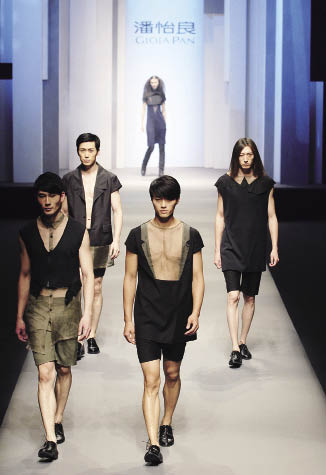| Gender Bending– Social Trends You Can Wear
By staff reporter HU YUE
PASSING for a member of the opposite sex is a tirelessly amusing trick celebrated in several art forms over many centuries and in many cultures. In 1998, Walt Disney Pictures made the animated film named Mulan based on a story from the Sui Dynasty (581-618) about a Chinese legendary heroine Hua Mulan. Mulan impersonated a man and took the place of her ill father in the ranks of the army fighting invaders from the north. For her bravery in assuming a male role, and the sacrifice she made for her father, Mulan has been honored in history. There are many such female heroines in Chinese history, fictitious and real, such as Fan Lihua of the Tang Dynasty (618-907) and Qin Liangyu of the Ming Dynasty (1368-1644) whose legends celebrate female ferocity and their awakening to inner strength and power.
 |
|
Gioia Pan’s collection shown in the 2011 China Spring Fashion Week. Wei Yao |
Two world wars and the demand on women to enter the labor force had an irreversible effect on fashion in the West. China was also experiencing a social transformation. After 1949 when the People’s Republic of China was founded, the social status of women saw a great improvement. However, the focus on production and construction made that an era in which fashion was hardly a possibility, let alone a priority. Those days finally gave way in 1978 to the reform and opening-up policy, leading to the development of a Chinese fashion industry over the next few decades. But the gender-neutral wind didn’t sweep the country until the new millennium. The “Super Voice Girl” singing contest, which was a grand, televised party for amateurs who wanted to show off their vocal talents, became quite a hit in 2005. The two winners that year, selected in front of the TV audience, were Li Yuchun and Zhou Bichang, whose tomboy images, as much as their performance and singing styles, soon sparked a craze for gender-neutral clothing styles around the country.
The popularity of asexual fashion gradually influenced ordinary people, especially the younger generation. Sanlitun is one of Beijing’s busiest commercial areas, as well as a popular site for local young people to shop. Do a little people-watching there and you will find that one in five girls is dressed like a boy. Some of them simply defy a gender category. But they don’t look strange at all; in fact their personalized boyish gear helps bring out their confidence.
Zhang Ran is a girl majoring in film and television production at Beijing Normal University. As a member of the generation born in the 1990s, she shared her opinions with China Today: “Since my childhood I have liked wearing jeans, jackets and sports suits because I like playing sports such as basketball or going jogging. Boys’ clothes are much more convenient compared to girls’ dresses and lacey skirts. I still prefer the simple lines and cuts of menswear,” she says and smiles, “and I don’t see any problem with girls wearing boys’ clothes. In modern society we don’t have to follow the conventional aesthetic standards of our parents’ generation that dictates that a girl should have long hair and wear high-heeled shoes to show her femininity. Society is becoming more and more tolerant and offers young people more choices. Some girls prefer simple and classic masculine clothes and maybe that is how neutral fashion came into being.”
Gender neutrality isn’t only a woman’s wardrobe game. Similarly, in recent years it has been considered fashionable for men to wear feminine garments.
|
